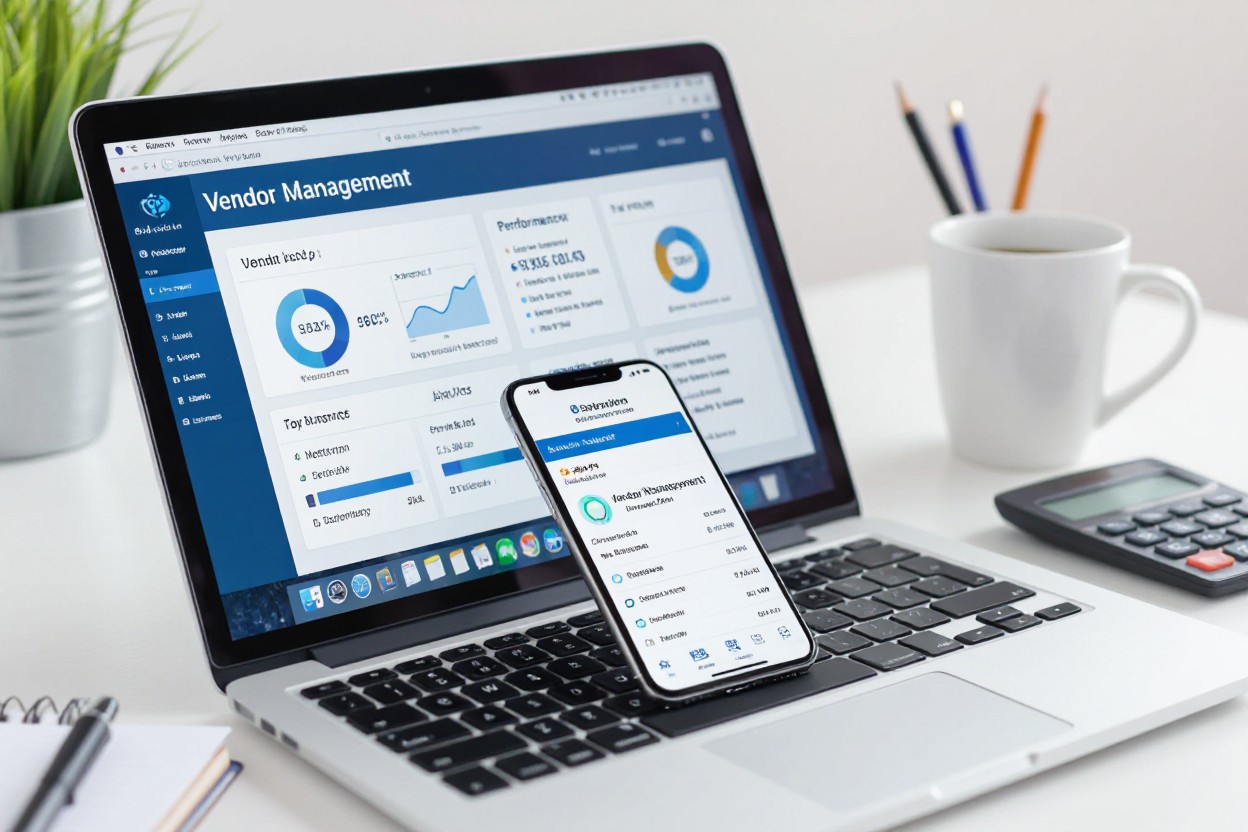What is a Vendor Management System (VMS)? 3 Powerful Reasons It’s Essential for Procurement Success

It’s vital for you to effectively manage your contingent workforce, and a Vendor Management System (VMS) offers a comprehensive solution to do just that. By streamlining the sourcing, engaging, and payment of nonemployee workers, a VMS helps you improve cost control, compliance, and operational efficiency. Without it, gaps in tracking external workers can expose your organization to significant financial and reputational risks. Leveraging a VMS empowers you to make faster, more informed decisions and build a unified workforce strategy that drives success.
Key Takeaways:
- A vendor management system (VMS) is software designed to manage the entire lifecycle of contingent workers, including sourcing, engaging, managing, invoicing, reporting, and offboarding.
- VMS helps organizations control cost, efficiency, quality, and risk by consolidating workforce management tasks into a single platform.
- The system supports multiple teams across an organization—such as HR, finance, and IT—by providing accessible data for improved workforce planning and strategy.
Defining the Roles: Vendors and Contingent Workers
The Landscape of Vendor Relationships
Vendors in the workforce management context encompass more than just suppliers—they include staffing agencies, outsourced service providers, and managed service providers (MSPs) who deliver contingent talent to your organization. These relationships often involve complex contractual agreements, performance metrics, and service level expectations that require careful coordination and monitoring. Using a vendor management system allows you to consolidate this network of suppliers into a single, streamlined platform, giving you real-time visibility into vendor performance, spend, and compliance.
In many cases, multiple vendors operate concurrently to supply different categories of contingent workers or specialized services. This diversity in vendor types can increase administrative overhead and risk exposure if managed manually. A VMS lets you centralize vendor data and standardize processes to mitigate such risks, helping maintain consistent quality and adherence to corporate policies. You’ll find that well-managed vendor relationships can lead to negotiating better rates, improving talent quality, and accelerating the delivery of services critical to your projects.
Understanding Contingent Workers in the Modern Workforce
Your contingent workers span a variety of roles—from temporary employees and independent contractors to consultants, freelancers, and gig workers. These individuals operate outside the traditional employment model but contribute crucial skills and flexibility to your organization. The contingent workforce has grown to represent up to 40% of total labor in some industries, driven by demands for agility and specialized expertise. Recognizing the different workforce segments helps tailor your management approach and ensures compliance with labor regulations tied to each classification.
Tracking vital details such as worker classification, contract duration, billing rates, and skill sets becomes manageable when integrated into your VMS. This systematic oversight lets you align contingent staffing with business goals, quickly respond to shifting market needs, and optimize labor costs. Because terminology and definitions may vary between vendors, agencies, and even legal jurisdictions, the system provides a single source of truth for all parties involved, preventing costly misclassification or contractual errors.
Extending beyond traditional temporary roles, the modern contingent workforce now includes project-based collaborators and specialized contractors who engage on Statement of Work (SOW) agreements, further complicating management without the right technology. Your VMS supports these complexities by centralizing worker profiles, enabling you to evaluate the right talent fit quickly and manage diverse engagement types effectively—giving you a strategic advantage in workforce planning and execution.
The Necessity of a Vendor Management System
Expediting Workforce Decisions: Access to Nonemployee Information
Rapid access to accurate nonemployee data transforms how you make workforce decisions. Instead of piecing together fragmented information from disparate sources, a VMS consolidates critical details—such as worker status, contract terms, rates, and performance metrics—into a centralized platform. This streamlined visibility lets you swiftly evaluate your contingent workforce and identify skill gaps, available resources, or budget constraints, enabling quicker and more informed choices regarding sourcing and engagement.
For example, organizations leveraging a VMS have reported up to a 30% reduction in time-to-hire by immediately accessing vetted vendor pools and worker profiles. By automating record keeping and updating live data, a VMS also eliminates delays caused by manual audits or lost paperwork, giving you real-time insights to optimize workforce allocation and accelerate project delivery.
Enhancing Security and Compliance in Workforce Management
Managing a diverse extended workforce demands rigorous compliance oversight and stringent security measures. Vendor management systems safeguard your organization by maintaining comprehensive records of worker credentials, contract compliance, and employment status. This reduces the risk of noncompliance with labor laws, tax regulations, and contract terms, which can otherwise lead to costly penalties or audits. Additionally, a VMS helps you monitor vendor performance and adherence to company policies, creating an enforceable framework that protects your organization’s reputation.
Security protocols built into a robust VMS go beyond basic data storage—advanced systems incorporate encryption, role-based access controls, and automated compliance workflows validated by third-party assessments. These features help shield sensitive worker and organizational data from breaches while ensuring adherence to regional data privacy regulations, including GDPR and CCPA. The result is a secure, auditable system that supports both internal governance and external regulatory demands.
The security advantage of a vendor management system extends to continuous risk mitigation. By automatically flagging expired certifications or contract anomalies, the system keeps your program proactively compliant rather than reactive. Integration with global tax and employment law databases further strengthens your ability to navigate complex geographic compliance challenges without manual intervention, safeguarding your operations as your extended workforce scales worldwide.
Unpacking the Advantages of a VMS
Streamlining Operations: Automation of Manual Processes
Manual workflows like contract approvals, time tracking, and invoice processing can consume countless hours and are prone to human error. A VMS automates these repetitive tasks, transforming them into seamless, digital workflows that reduce administrative overhead and speed up cycle times. For example, automated invoice reconciliation ensures that payments are processed accurately and on schedule, minimizing late fees and discrepancies.
Automation also enables your team to focus on strategic priorities instead of routine paperwork. By eliminating tedious manual entry, you improve data accuracy and compliance while accelerating hiring and onboarding efforts. Organizations using a VMS report up to a 30% reduction in time spent on administrative tasks, allowing you to redeploy resources toward critical workforce planning and talent acquisition.
Achieving Greater Workforce Visibility Across Categories
Visibility into your entire contingent labor pool—across temporary workers, consultants, freelancers, and outsourced service providers—is often scattered and incomplete without a centralized system. A VMS provides a consolidated view of headcount, labor spend, worker locations, and contract status, giving you a comprehensive understanding of your external workforce makeup.
With access to real-time data, you can track workforce utilization patterns, identify skills gaps, and optimize resource allocation. For instance, one education provider leveraged VMS reporting to identify underutilized talent segments and reassign workers to high-demand projects, boosting productivity by 15% within six months.
Digging deeper, this heightened visibility allows you to drill down into workforce categories by contract type, department, or geography—ensuring that decisions are informed by accurate, holistic data. You gain the ability to anticipate labor costs, forecast hiring needs, and proactively manage compliance risks globally, all from a single system of record.
Core Features of an Effective Vendor Management System
Supplier Management and Order Distribution
Supplier management within a VMS lets you centralize all vendor-related information—from contract details and compliance status to performance metrics—in one accessible repository. This centralized approach gives you the ability to monitor vendor performance over time, helping identify high-impact suppliers and flagging those that may need corrective action. With real-time updates and comprehensive dashboards, you gain enhanced visibility into vendor relationships, enabling more strategic sourcing and negotiation efforts that reduce costs and improve service quality.
Order distribution capabilities automate the allocation of work across multiple suppliers based on predefined criteria such as skill requirements, availability, and historical performance. By leveraging intelligent routing rules, your VMS can ensure that orders are assigned to the most qualified vendors quickly, minimizing delays and maximizing efficiency. This automation reduces manual administrative tasks, accelerates time-to-fill, and maintains consistency in how contingent labor is sourced across your organization’s departments.
Integrated Billing and Risk Mitigation
Integrated billing streamlines the financial reconciliation process by consolidating invoices from multiple vendors into a single, unified platform. This simplifies tracking payments and budget adherence, providing clear insights into contingent labor spend at both granular and aggregate levels. Automated invoice validation checks reduce errors and billing disputes, so you can accelerate approvals and optimize cash flow management.
Risk mitigation features embedded in a VMS help you proactively address compliance and security challenges by monitoring contractual obligations, certifications, and worker classifications. Customizable alerts notify you of approaching expiration dates or lapses in required documentation, while audit trails maintain detailed records of all vendor interactions. These tools work together to reduce exposure to regulatory penalties, financial losses, and reputational damage stemming from non-compliance or mismanaged contracts.
Together, integrated billing and risk mitigation provide a comprehensive financial and operational control framework. This ensures that both your spend and workforce compliance are continuously monitored, allowing you to respond rapidly to evolving regulatory environments and internal policy changes.

Navigating Global Compliance with VMS
Addressing Local Regulations: A Global Workforce Challenge
Managing a global extended workforce means confronting a patchwork of local regulations that can differ widely from one country to another. Your vendor management system should handle these variations seamlessly, whether it’s navigating diverse invoicing requirements or complying with complex employment laws. For example, in the European Union, strict data privacy rules under GDPR require meticulous handling of personal worker data, while countries like Brazil impose unique tax structures that influence pay calculations.
Local currency billing and country-specific tax treatments add layers of complexity to workforce management. A VMS that supports multiple currencies and automates rate conversions lets you streamline payments without losing accuracy or compliance. You gain the agility to respect local labor laws, tax deductions, payroll reporting, and invoicing practices, all within a centralized digital system—minimizing the risk of penalties and costly compliance gaps across borders.
Comprehensive Reporting for Informed Decision-Making
Global compliance cannot be effectively managed without comprehensive reporting tools that give you a consolidated view of your contingent labor data. Configurable dashboards provide insights into spend by country, contract type, or vendor, enabling you to spot trends, flag anomalies, and forecast workforce needs with precision. This kind of reporting ensures you aren’t operating in silos but instead have holistic visibility over contingent labor categories and locations.
By centralizing data from multiple jurisdictions, your VMS helps you confidently produce detailed reports for internal audits, regulatory reviews, and strategic planning. Whether your organization needs to analyze contract compliance, verify labor allocations, or prepare tax filings, the ability to generate accurate, up-to-date reporting underpins sound decision-making and helps you mitigate workforce risks globally.
Beyond operational tracking, advanced reporting empowers cross-functional teams—finance, HR, legal—with actionable intelligence. Easily segmented data supports compliance monitoring and workforce planning, while built-in analytics can highlight cost-saving opportunities or compliance gaps you might otherwise miss. This empowers you to transform raw data into strategic insights that support global business growth and regulatory adherence.
Prioritizing Security in Vendor Management Systems
The Importance of Data Protection and Compliance
Your vendor management system houses a wealth of sensitive data, including personal information of contingent workers, financial details, and proprietary organizational insights. Protecting this data from breaches, unauthorized access, and manipulation is fundamental to preserving your company’s reputation and operational integrity. Failure to secure this information can result in costly fines, damaging legal repercussions, and erosion of trust among your workforce and business partners.
Regulations such as the GDPR in Europe, CCPA in California, and other regional data privacy laws impose stringent requirements on how worker data must be stored, processed, and shared. A VMS that integrates automated compliance checks and real-time monitoring helps you actively mitigate legal risks and ensures that each phase of the contingent worker lifecycle adheres to applicable laws and standards. This proactive approach aids in avoiding fines and penalties while giving you confidence that your extended workforce complies with complex data protection mandates worldwide.
Evaluating Security Features in VMS Offerings
When deciding on a vendor management system, you should verify that its security architecture includes multi-layered protection mechanisms such as encryption at rest and in transit, role-based access controls, and regular vulnerability assessments. For example, a VMS utilizing 256-bit AES encryption helps safeguard your data from interception and unauthorized disclosure, while dynamic user permissions restrict information access only to those who need it for their role.
Look for VMS providers that engage third-party auditors to validate their security protocols through certifications like SOC 2 Type II or ISO 27001. These certifications demonstrate ongoing compliance with industry best practices and indicate a commitment to continuous security improvements. Additionally, features such as detailed audit trails enable your organization to track access history and user activity, bolstering your ability to detect suspicious behavior quickly and satisfy regulatory reporting requirements.
Beyond technical safeguards, assess how well the VMS integrates security automation tools that can flag anomalous behavior or potential insider threats in real time, empowering your security team to respond promptly and reduce risk exposure throughout the external workforce management process.

Integrating VMS with Human Capital Management
The Shift Towards a Holistic Workforce Strategy
Your organization’s workforce is evolving beyond traditional full-time roles to include contractors, consultants, gig workers, and automated bots. Managing these diverse worker types with isolated systems limits your ability to see the full picture of workforce capacity and spend. By integrating your vendor management system (VMS) with human capital management (HCM), you break down silos and create a unified approach to workforce management that reflects this new reality.
Such a holistic workforce strategy positions you to optimize resource allocation and talent utilization across all employment categories. It enables real-time visibility of combined employee and contingent worker data, facilitating strategic decisions that align with business goals. For example, you can dynamically shift projects between internal staff and specialized contractors based on availability and skill requirements, improving agility and operational efficiency at scale.
Benefits of Seamless Data Flow Between Systems
Integrating your VMS and HCM solutions allows data to flow seamlessly, eliminating duplicate entry and reducing errors. When worker profiles, assignments, compensation data, and compliance documentation synchronize automatically, teams across HR, procurement, and finance gain immediate access to up-to-date information. This transparency accelerates onboarding, payroll processing, and reporting processes while minimizing administrative overhead.
Additionally, centralized data supports comprehensive analytics and forecasting. For instance, analyzing combined worker types and spend patterns helps uncover gaps in talent supply or budget overruns before they impact projects. You can also leverage this intelligence to optimize supplier relationships and negotiate better contract terms across your extended workforce. Gartner reports organizations integrating workforce systems experience up to a 30% increase in operational efficiency and heightened risk mitigation capabilities.
By linking your vendor management and human capital management platforms, you create a scalable infrastructure that adapts to your evolving workforce needs. This integration empowers smarter, faster decisions that drive cost savings, compliance, and strategic workforce planning all from a single, cohesive technology environment.

Essential Components of a Robust Vendor Management System
Extended Workforce Management: A Comprehensive Approach
You gain the ability to oversee the entire lifecycle of your external workers through extended workforce management capabilities. This holistic approach encompasses sourcing, onboarding, managing, invoicing, and offboarding, ensuring that every stage of the contingent worker’s journey is streamlined and transparent. By centralizing these processes, you not only reduce administrative overhead but also create a more agile environment where decisions are backed by real-time data on labor utilization and spend.
Organizations that implement robust extended workforce management can expect improved forecasting and budget control. For example, integrating spend data with worker performance metrics allows you to pinpoint where skills gaps exist or where external talent is driving project success. This comprehensive vantage point supports proactive workforce planning and ultimately enhances your ability to align contingent labor with evolving business priorities.
Statement of Work (SOW) Management Capabilities
SOW management within a VMS enables you to handle complex projects involving contractors and consultants with clear, enforceable scopes and deliverables in one centralized platform. This functionality supports mapping out the requirements and milestones associated with each statement of work, giving you greater control over timelines, budgets, and compliance. Consolidating SOW processes eliminates the risks of project delays or scope creep that can occur when information is scattered across multiple systems.
Accurately tracking SOWs ensures that contingent labor aligns with contractual commitments, which can significantly reduce administrative errors and billing disputes. Many organizations leveraging these features report enhanced project visibility and governance, empowering them to allocate resources dynamically and maintain better relationships with external service providers.
Additionally, SOW management tools often come with built-in audit trails and contractual compliance checks, which help you maintain regulatory adherence and document every change or approval. This opens the door for stronger partnerships and more reliable delivery of critical projects managed outside your traditional workforce.
Worker Profile Management for Informed Decision Making
Worker profile management allows you to maintain detailed, up-to-date records of your contingent workforce, capturing vital information such as roles, skills, assignment durations, rates, and performance feedback. This consolidated worker data acts as a single source of truth, eliminating the guesswork often involved in managing diverse, flexible teams. By having immediate access to this information, your team can swiftly evaluate workforce availability, cost implications, and potential conflicts before making resource decisions.
Detailed profiles also facilitate compliance tracking and help with talent auditing, ensuring workers meet required certifications and contract terms. Integrating profile management into your VMS means onboarding and offboarding processes are smoother, because you can automatically verify worker details before assignments begin and confirm completion upon exit.
Maintaining comprehensive worker profiles reduces both risk and spend leakage by enabling you to monitor labor costs against budget in near real time. This visibility supports negotiation and sourcing strategies by providing evidence of individual and vendor performance trends across your extended workforce.
Harnessing AI for Enhanced Vendor Management
The Impact of Machine Learning on Recruitment
Machine learning algorithms integrated into your VMS can sift through thousands of candidate profiles in seconds, identifying the best matches based on experience, skills, and rate requirements. This targeted shortlisting reduces hiring cycles by up to 50%, enabling your HR and procurement teams to focus on engaging the right talent instead of getting bogged down in manual screening. For example, VMS platforms using AI have helped enterprises streamline recruitment for specialized roles, where matching nuanced skill sets and contract terms is complex and time-consuming.
Beyond matching qualifications, AI-powered recruitment can also predict candidate success by analyzing historical data on workforce performance and tenure, helping you reduce turnover among contingent workers. By leveraging machine learning insights, your organization gains not only faster hiring but also improved quality of hires, which translates to enhanced project delivery and lower operational risks.
Unlocking Cost Savings and Efficiency Through Automation
Automation within your vendor management system can drastically reduce repetitive administrative workloads such as onboarding, timesheet approvals, and invoice processing. For instance, automated workflows ensure that contingent worker profiles are promptly updated with compliance certifications, eliminating manual errors that can lead to costly regulatory penalties. Organizations have reported up to 30% reductions in administrative overhead after implementing automated task management through their VMS.
Automated budget tracking and spend analysis features provide real-time visibility into vendor costs and contract utilization, enabling you to identify overspending and negotiate better rates. By centralizing these processes, you remove bottlenecks that delay payments and obscure spend data, directly contributing to improved cash flow and vendor relationships.
Further expanding on automation benefits, your VMS can integrate with payroll and financial systems to synchronize data seamlessly, reducing invoice discrepancies and accelerating billing cycles. This level of automation not only saves time but also increases accuracy, ensuring that you pay the right amount at the right time—minimizing financial leakage and contributing to tighter fiscal control across your contingent labor program.
To wrap up
Following this overview, you can see that a Vendor Management System (VMS) is a comprehensive tool designed to help you manage your contingent workforce efficiently—from sourcing and onboarding to invoicing and offboarding. By consolidating the entire lifecycle of your external talent into a single platform, a VMS enables you to make faster, more informed decisions while maintaining visibility over costs, compliance, and overall workforce performance.
With features that support global compliance, risk mitigation, and integration with other workforce management systems like HCM, a VMS positions you to optimize your extended workforce strategy effectively. Leveraging capabilities such as AI-driven recruitment and detailed worker profile management, you gain the agility needed to adapt to evolving business demands and maintain a competitive edge in managing contingent labor.
FAQ
Q: What is a Vendor Management System (VMS)?
A: A Vendor Management System (VMS) is a software solution designed to manage the entire lifecycle of contingent workers. It helps organizations source, engage, manage, invoice, report, and offboard nonemployees efficiently from one centralized platform. This enables better control over cost, quality, efficiency, and risk related to the external workforce.
Q: Who qualifies as a vendor in the context of a VMS?
A: In the context of workforce management, a vendor refers to individuals or organizations supported by VMS technology. This includes contract employment agencies, service providers, and the contingent workers themselves. Essentially, vendors are the sources of external talent that contribute to a company’s extended workforce.
Q: What types of workers are managed through a Vendor Management System?
A: A VMS manages contingent workers—those who work for an organization but are not direct employees. Examples include temporary workers, consultants, freelancers, and gig workers. These diverse worker types are supported through the VMS to provide greater visibility and control over the external workforce.
Q: How does a Vendor Management System support global workforce compliance?
A: A VMS assists organizations in managing global compliance by handling varying local regulations related to invoicing, employment laws, tax structures, and currency requirements. It centralizes data from multiple countries, helping organizations avoid penalties, streamline reporting, and reduce risks associated with cross-border workforce management.
Q: What are some key features of a modern Vendor Management System?
A: Modern VMS platforms typically include features such as supplier management, order distribution, consolidated billing, risk mitigation, headcount tracking, and improved reporting capabilities. Many also support management of statement of work (SOW) consultants and outsourced services, allowing organizations to effectively track and manage extended workforce needs in one place.

